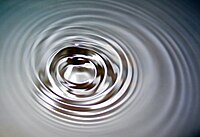
Photo from wikipedia
The cross-correlation filtered Rayleigh scattering method is presented for planar measurements of time-averaged velocity, temperature, density, and pressure using laser scanning, Rayleigh scattering, and cross-correlation-based signal processing. Of particular note,… Click to show full abstract
The cross-correlation filtered Rayleigh scattering method is presented for planar measurements of time-averaged velocity, temperature, density, and pressure using laser scanning, Rayleigh scattering, and cross-correlation-based signal processing. Of particular note, the methods and analyses presented show that velocity and temperature measurements are obtainable at acceptable uncertainties for many aerodynamic applications with or without particles present. In the current work, velocity and temperature measurement uncertainties for this method are analysed by Monte Carlo simulations and evaluation of the Cramer–Rao lower bounds for the signals generated in this approach with aerodynamic applications in mind. A key aspect considered is the relative strength of Rayleigh (molecular) scattering and Mie (particle) scattering contributions to the simulated flow signal. Compared to particle-based velocity estimation, the effects due to convolution between the molecular filter and the broadband Rayleigh scattering spectrum are found to increase the estimator variance of the velocity. For given flow conditions, the velocity error associated with the signal processing routine with noise-free signals is found to be less than , and bias error associated with discrete sampling in the laser frequency domain is within . For these same conditions, temperature measurement simulations indicate bias error bounds of 0. 014% with random uncertainty bounds of less than ±1.4% for a signal with no Mie scattering contribution, and bias error bounds of less than ±0.14% with random uncertainty bounds of less than 3.2% for flows contaminated with Mie scattering sources at a signal-to-noise ratio of 25 dB or greater. This technique is also being further developed to measure density and pressure using the principles of laser Rayleigh scattering in flows containing particles of unknown sizes and concentrations.
Journal Title: Measurement Science and Technology
Year Published: 2019
Link to full text (if available)
Share on Social Media: Sign Up to like & get
recommendations!